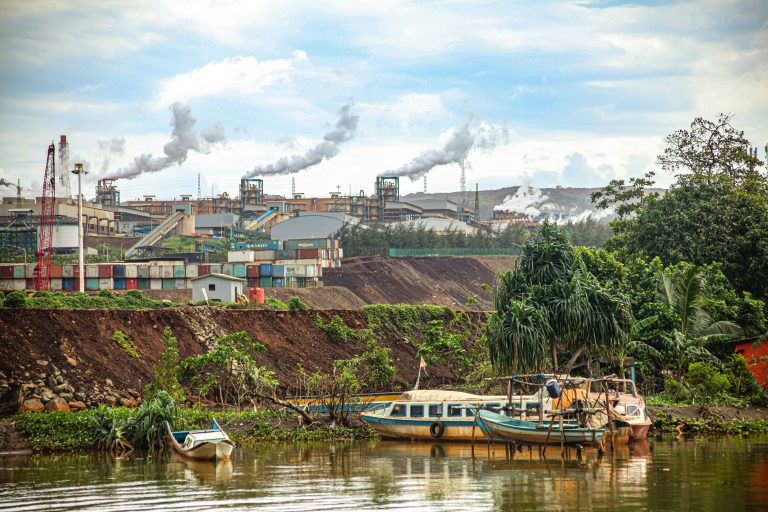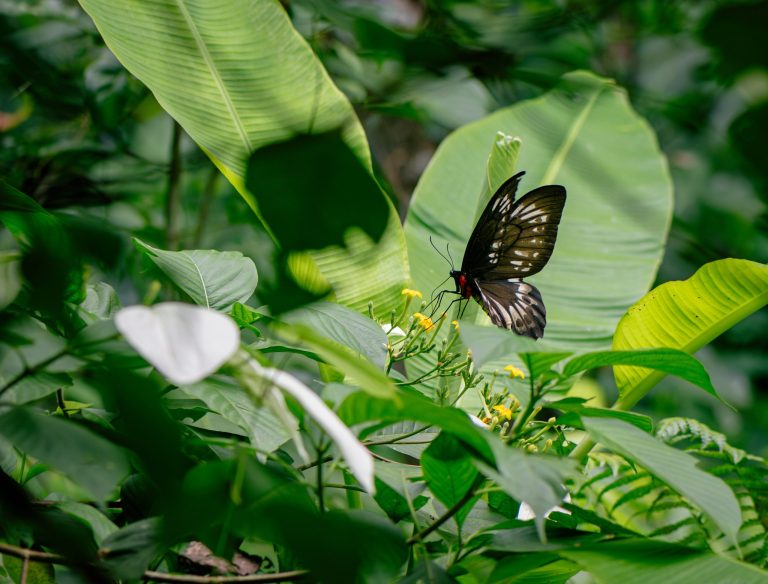When Amanda Wamblolo was young, she never had any difficulties finding food.
Living in Yoka, on the eastern shore of Sentani Lake in Jayapura, Papua, between an expanse of hills and dozens of rivers flowing down the Cyclops Mountains, she enjoyed an abundance of carbohydrate-rich foods, including yameha (thorny sago); yeba (fine sago); yara, fam or ninggei (types of sweet potato); hekei (taro); and imfeuw (banana).
There was no shortage of choices for vegetables either, such as hio (a spinach-like green), manggali (gedi plant greens) and weare (wax plant greens).
All sorts of fish also populated the lake, including what the Papuans call khayouw (Sentani Lake cork fish), khahe (red and black cork fish), khandei (gete-gete fish) and himem (yellow and black cork fish). Anyone was free to catch them, women or men, alone or in a group.
“The old food is simple but good. Have papeda with the fish from the lake. Cook them just like that. You can also have it with vegetables. There’s fern, spinach. [We can] eat roasted caladium with boiled or roasted fish,” said Amanda, who is now 67 years old.
Before it became known as Yoka, the village was called Hebeibhulu. The name was derived from the ancestors of the first tribe that lived in the village. The new name, Yoka, emerged during the Dutch colonial era. At the time, Yoka was a center of public activity, including education.
“Yoka” consists of the words yo (village) and kha (fish) in the local language.
Administratively, Yoka village is part of the Heram district of Jayapura. It is adjacent to Waena, one of the most populous areas of the Papuan capital.
At one time, the north part of Yoka village was a sago farm. Then, a development and food program begun during President Soeharto’s regime slowly changed the landscape and the consumption patterns in Yoka village.
A number of sago farms were cut down, and houses, schools, places of worship, trade buildings and others were built in their place. The buildings even occupied the lakeside. In several spots, the houses sank into the ground, as if sucked into the former sago swamp.
“In 1974, people started to occupy the area, but it remained a sago farm. There were no houses. There were no changes. In 2001, the sago was demolished and buried. Very rapid changes,” said Amanda.

Nature’s Abudance
In Yoka village, Kristina Suebu and Ricky Mebri, a couple, still routinely consume banana, sweet potato and sago, all from their own orchard. But there is now rice among these staple foods. They set it aside for their children and grandchildren who prefer it as a source of carbohydrates.
Kristina said their favorite foods were never really gone. When they were nearly finished, the family could simply go to their orchard and plant more.
The village where they plant their food and from which they take their sago is called Boboli. Located further to the south, Boboli is mostly forest. An orchard stands in the middle of the village. Often, people encounter animals like wild boars. A fence has been set up to protect the orchard. In a week, the family visits the orchard once or twice to collect food.
They store the sago flour in four big buckets. Three buckets for the family and one bucket for their hogs and dogs. To make it last, the sago flour is soaked in water to keep it wet. The water must be changed periodically. Usually, the flour extracted from the trunk of a sago tree can last three months.
“If you want to eat papeda [sago porridge], you can catch some fish, then we eat,” said Kristina.

Some parts of the family’s house stand directly on top of the lake. Only a small portion of the building touches the soil. Fishing there is easy. Just cast the lure from the back porch, and you will get a fish.
The Sentani people have for generations stayed in villages surrounding lakes, from the shores of Jaifuri Lake in the east, whose water flows into the Pacific Ocean, to Yakonde in the West. They have also lived in villages on the islands in the middle of the lakes.
Sentani is a tectonic lake surrounded by hills. It is also surrounded by savannah, forests and sago groves spread across the plains and gently sloping hills. It only makes sense that the Sentani people get their food by processing sago, creating an orchard within the surrounding forest and fishing on the lake.
Since the louhan (flower horn) fish breeds in the lake, this type of fish is the one most often captured in the nets, alongside the tilapia fish and cork fish. Sometimes families get tilapia from a fish cage on the back porch. The catch can be sold or consumed.
Flower horn fish are not actually native to Sentani Lake. Some Yoka people say the louhan fish first appeared in the area after its eggs were cast into the lake during a Chinese New Year celebration. The louhan is said to be a gift from outsiders to the Sentani people.
Another version of the story is that the lake’s louhan population originated from some ornamental fish that escaped a household aquarium during a flood. The fish then bred and ate endemic fishes’ eggs. Louhan fish in Sentani have sharp fins and are covered by a number of scales.
Angling for Successors
Yan Pulalo, 29, usually sets out in the early morning. At around 6 a.m., the father of three can usually be found standing in the middle of the lake, watching over his fishing net.
He usually captures catfish, tilapia and redfish. The catfish are usually caught 100 to 200 meters from shore, while the tilapia and redfish are usually caught along the edge of the lake. He then separates his catch into two parts, one to be sold, the other to be eaten.
On a good day, he can earn up to Rp 700,000 (US$45.49). On more modest days, he may make some Rp 300,000. If there are no buyers at all, he will take the fish home, smoke them and sell them at the market the next day.
Yan is one of the few young people in Yoka Village holding on to the profession of lake fisherman. It does not take much investment to fish. A net and fuel for his boat are all he needs to do the job, and he manages to survive the days where he brings in a poor catch.
“I think being a fisherman enables you to fulfill the household needs. You get up in the morning to set the net, and you can eat [the fish] or sell them. It can help financially,” Yan said.
Yan does not fill his plate with vegetables cultivated in his own garden. He said he rarely ate local staples like bananas, sweet potatoes or sago. Only his parents ate the papeda from the farm. He usually bought rice and vegetables.

The government’s food program is one of the reasons for the changes in Papua’s local cuisine, combined with the influence of immigration on Jayapura, which has become a much more heterogeneous city.
Migrant shop owners selling non-native ingredients and warung (stalls) offering cuisines from outside Papua have slowly influenced local diets to favor white rice as a staple. This has also shifted younger generations’ tastes, said Yoka village head Antonius Mebri.
“We cannot fight the [changes] of the time. Young people are born and raised in a consumerist era. You enter a warung, you eat, as long as you have money. The old people were born in the production era. You plant [the food] yourself, and you eat it. That’s the problem,” said Antonius.
He also highlighted the decreasing number of young farmers and fishermen due to the increasing income of the villagers, partially attributable to a village administration program that encourages one member of each household to obtain a university degree. Typically, once young Papuans obtain their degrees, they choose professions other than farming or fishing.
Just like Antonius, Amanda said the younger members of her family often bought ingredients from the market or meals from warung. Some also copied the custom of immigrants: buying food from the market and then reselling it in the village.
From Amanda’s point of view, the decreasing number of farmers and fishermen in the area had limited the availability of local cuisine. Also, many local residents preferred instant noodles to local Papuan cuisine.
“Right now, rice is the main food. Sago is often unavailable. […] It used to be easier to get in the past. The mamas [Papuan women] who farmed used to share their harvests,” said Amanda.
Struggle against Extinction
It has been three months since couple Ulin Epa and Fredrik Bartolomeus opened their restaurant. Located on the shore of Sentani Lake, it has a vast open space with a direct view of the lake and the hills.
The restaurant’s name, Isasai, was inspired by one of the rivers that flows not far from the restaurant. Isasai means “house of fish”, an image that is closely connected to Sentani Lake as a major regional fishing locale.
Isasai offers a variety of local foods, such as papeda and wrapped papeda, roasted sago, boiled sweet potato, mashed sweet potato, boiled banana, salted fish and boiled fish.
“We want Isasai to put a spotlight on local foods that are rarely available. Usually, in city streets, you can only find salads. How come we in Papua can’t have the food that we usually get when we’re in the village, that kind of food, the food from our childhood?” asked Fredrik.
The ingredients used by Isasai are all purchased from mama-mama Papua (Papuan moms). If Isasai manages to keep growing as a business, the couple hopes to buy more produce from Papuan women.
“Recently, there have been more elderly people coming [to the restaurant] because they can see that the food here is mostly boiled or salted. So the purpose is so that people can eat healthy food,” he continued.
The restaurant does not just offer local Sentani cuisine, it is also a place to learn about nature and culture.
In the middle of the restaurant, there is information on the Sentani people’s traditional conservation methods, which are slowly disappearing. The walls of the restaurant are also adorned with various animals endemic to Sentani Lake.
With the variety of healthy Papuan foods, the owners hope young Papuans in other areas can also contribute to the local cuisine’s revival.

Local Food, Local Politics
Fadli Rahman, a food historian and a history lecturer at the Cultural Faculty of Padjadjaran University in West Java, said the movement to conserve local cuisines required serious government support.
In Papua, Isasai is not the first restaurant to push for food conservation. A movement by a collective called Jungle Chef led by Charles Toto has also sought to preserve Papua’s unique cuisines.
“In local cuisine movements as political movements, they educate people to return to their original tastes and to rediscover the potential of their local cuisines,” said Fadli.
He added that there were two important aspects to reviving local cuisine. First, local people needed to maintain and defend the food ecosystem, and second, they needed to strengthen their local food culture.
“[When] the culture has been weakened by the surrounding instant food and [foreign] food industry, there will also be less attention paid to the food ecosystem,” said Fadli.
Indonesia’s rice-focused food policy since the 1970s has made the grain the chief staple for Papuans, both in cities and rural areas. The shift of agricultural land toward rice cultivation, urban development and the plantation industry has also added to the problems, according to Fadli in a 2018 column titled “Kelaparan-Kelaparan Tersembunyi” (Hidden Hungers).
The importance that Papuans place on local cuisine in everyday life has slowly diminished.

In Yoka village, easy access to food from outside has made food shortages less common, and the dependence on money to buy food has made the villagers less inclined to produce their own food.
Nonetheless, according to Amanda, sometimes there are situations where the villagers run out of food.
“In the house, people run out of rice. That’s not uncommon. They get hungry. ‘Ah, today I won’t cook, I’m hungry, the rice is out.’ We have become like outsiders because we don’t have our own farms. If the rice is out, that’s it, we just have to take care of each other like family, share a little bit,” said Amanda.
There has been little research on the impact of the dietary changes on the health of Papuans.
However, the head of Yoka’s community health center (Puskesmas), Dr. Melissa Hascatri, said the center had started to see metabolic syndromes typically found in older people in the area’s younger residents, such as decreased pancreatic function, which can lead to diabetes.
“Among the elderly, we find [diabetes] among those aged 50 and up. Now we take care of those who [have diabetes] in their 40s or 50s. Many are also under 40,” said Melissa.
She strongly suspected that the sugar level in rice and foods with processed flour like bread and noodles were the culprits.
Although the situation is difficult to change, Antonius said the scarcity of local cuisine had to be addressed eventually.
By the end of September 2022, the local government had established a pilot farm project to plant a variety of local foods. It had also set up fish cages in the lake.
“Now people often buy [food]. So, let’s call for [action]. This means we are calling for people to go back to farming what we consume and taking advantage of the land we have, the soil, the water and the forest. We utilize it ourselves, so we don’t have to buy [food] anymore,” Antonius said.
Translator: Farida Susanty
The story is part of a series on #IndigenousPeople.









